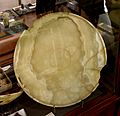Alabaster facts for kids
Alabaster is a special name given to two different types of minerals. One type is called gypsum, and the other is called calcite. Both of these minerals are easy to carve and look beautiful.
People have used alabaster for thousands of years to create many different kinds of art and objects. This includes small statues and decorative items.
It's easy to tell the two types of alabaster apart because one is much harder than the other. Calcite alabaster is quite hard, scoring a 3 on the Mohs scale of mineral hardness. This means it's harder to scratch.
Gypsum alabaster, on the other hand, is very soft. It only scores between 1.5 and 2 on the Mohs scale. You can even scratch it with your fingernail!
Another way to tell them apart is by using a special test. If you put a drop of hydrochloric acid on calcite alabaster, it will fizz and bubble. Gypsum alabaster does not do this.
Contents
What is Gypsum Alabaster?
Gypsum alabaster is the type of alabaster we usually talk about today. It is a calcium sulfate that contains water. This mineral often looks white and can be quite shiny.
Because it is soft, artists can carve gypsum alabaster easily. It has been used for centuries to make sculptures, vases, and other decorative items.
What is Calcite Alabaster?
Calcite alabaster is the type of alabaster that ancient civilizations used. It is a calcium carbonate. This mineral is also known as "onyx-marble" or "Egyptian alabaster."
Calcite alabaster was very popular in ancient Egypt and the Near East. They used it to make jars, statues, and other important objects for temples and tombs.
How Alabaster is Used
Alabaster has been a popular material for artists and craftspeople for a long time. Its soft nature makes it easy to shape and polish.
- Sculptures: Many beautiful statues and figures have been carved from alabaster.
- Vases and Jars: Ancient civilizations used it to create containers for oils, perfumes, and other precious items.
- Windows: In some old churches and buildings, thin sheets of alabaster were used instead of glass. They let in a soft, glowing light.
- Lamps: Modern designers also use alabaster to create lamps that give off a warm, diffused light.
Images for kids
-
Calcite alabaster cosmetic jar with a lioness, from the tomb of Tutankhamun.
-
Alabaster bust of Septimius Severus at the Musei Capitolini, Rome.
-
An alabaster workshop in Volterra, Italy.
-
Calcite dish from the Ancient Egyptian tomb of "U", Semerkhet.
-
Resurrection of Christ, a typical Nottingham alabaster panel from an altarpiece.
-
Statue of Ebih-Il, made of gypsum alabaster (25th century BC).
-
An alabaster statue from Yemen (1st century BC).
-
Alabaster monument of Nicholas Fitzherbert, d. AD 1473, in St Mary and St Barlock's Church, Norbury, England.
-
Alabaster window in Orvieto Cathedral.
-
Archaizing Relief of a Seated King and Attendants, Iran, Qajar period.
-
An alabaster lamp from Aachen Cathedral, Germany.
See also
 In Spanish: Alabastro para niños
In Spanish: Alabastro para niños





















